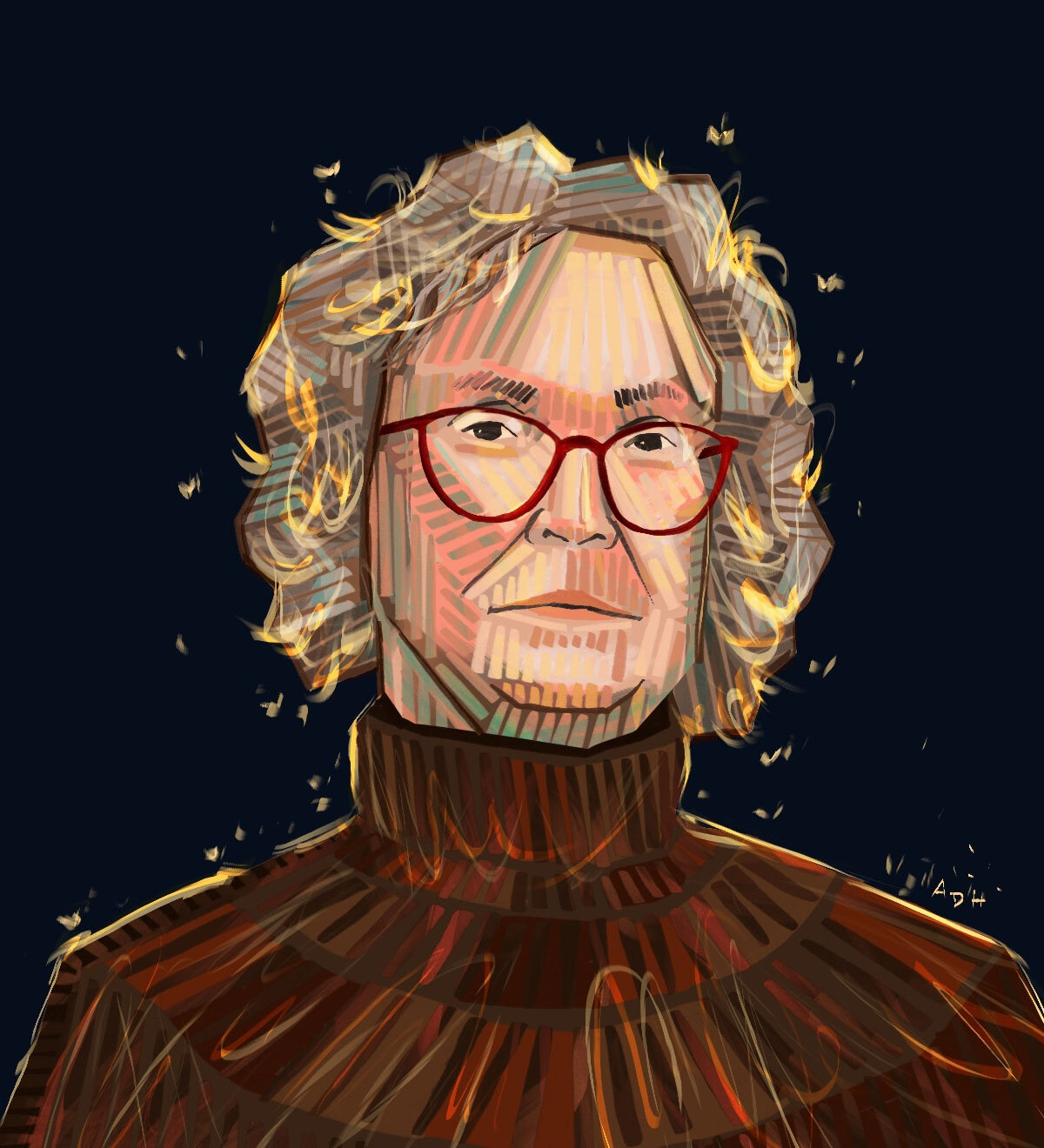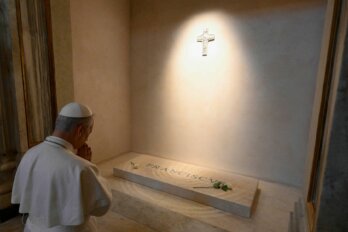Late in his career, the English poet W. H. Auden distilled the whole business of poetry into three pungent lines: “A poet’s hope: to be, / like some valley cheese, / local, but prized elsewhere.” Think of Appenzeller, Raclette, or—given Auden’s farmhouse in Kirchstetten, Austria—Tyrolean Grey. Such names are known high and low, the flavours often imitated, but in each case, the real thing belongs to one place and one place only.
I say this with the utmost deference: Mary Dalton is a valley cheese. A consummate poet, she is eminently local, her terroir the idioms and folkways of Newfoundland. Although she has been recognized over the past thirty-five years, her bracing poetry is overdue for widespread acclaim. Inseparable from the easternmost province, it deserves to be read here, there, and everywhere.
Dalton’s new book, Interrobang, is named for an awkward bit of punctuation that combines a question mark and an exclamation point. Betwixt and between, fundamentally ironic, it’s the typographical equivalent of WTF; in one poem, Dalton dubs it the “prince of ambivalence.” Chess experts and finicky readers use exclamation points to record smart moves and bons mots, while question marks flag dubious tactics and sloppy phrasings. But the interrobang muddles neat distinctions, fusing doubt and certainty, success and error. The title tells us that Dalton’s poems ask questions and make statements all at once—as good poems, like riddles, tend to do. Sixty years ago, the critic Northrop Frye proposed that “Where is here?” was the “riddle” at the heart of a “Canadian sensibility.” Dalton loves riddles, but her poems are sure of at least one thing: here is an island in the North Atlantic.
In Interrobang, Dalton is drawn to the evocative objects and heirlooms of that island: the shop bell that “announces an entry,” the money box that keeps “news of unpaid bills, unkept / promises to itself,” a blue bottle of “Gerald S. Doyle’s Newfoundland Cod Liver Oil” with its “stinking / gut-churning goodness.” Or, if not objects, specimens: “Tansy,” “Stinging Nettle,” “Dog Rose,” “Joe Pye Weed.” She alludes to the plants’ medicinal properties, largely forgotten now, as carefully as she documents the names of Holyrood clubs: “The Butterpot Tavern, Mother Hickey’s, Mary Anne LaCour’s, Davises’, Fureys’, Crawleys’.” Here, poet and community historian are virtually the same. But Dalton is no singer of shanties. Rather, she is an observant, almost anthropological poet whose scrupulous attention to her home place resists the flattening of language and culture. Her poetry captures what she calls “the tang and texture” of local speech.
If this sounds a touch quaint, rest assured that Dalton’s poems are rarely sentimental. They have few epiphanies and no grand pronouncements. Her poetry is cool, reserved, and seldom, despite its subject, folksy. A line from Interrobang could be a motto for Dalton’s eventual Collected Poems: “nostalgia be damned.”
It’s no secret that Newfoundland is home to talented authors: Michael Crummey, Wayne Johnston, Lisa Moore, Michael Winter. In poetry, it all began with E. J. Pratt, who published Newfoundland Verse in 1923, when Joey Smallwood and Confederation were still decades away. Dalton’s poetry has little in common with the nationalist epics that Pratt went on to write, but it follows in the mode of his spiky, consonant-clustered early work—and like him, Dalton is a major Canadian poet.
Born in 1950, she grew up on Conception Bay, “an area,” she writes, “rich in its oral culture” (despite schoolteachers’ hostility to local manners of speech). She pursued an academic career—she is now retired from Memorial University—and did not publish her first book of poetry until she was nearly forty. But if The Time of Icicles (1989) was a late start, it showed that the crucial imaginative pieces were already in place: a sense of location, scraps of argot, mythical allusions, an eye for flowers, and, above all, great formal facility. Moments of broad satire are uncharacteristic, but even “Larry’s Nightmare”—in which an oblivious creative writing professor is hectored by “three Newfoundland harpies” who pooh-pooh book deals with “McClelland and Mulroney”—reveals Dalton’s commitment to her milieu.
Subsequent collections confirmed her formal range and devotion to Newfoundland culture. In “Dandelions and Rhubarb,” from Allowing the Light (1993), Dalton refers to the “insignificant little / Newfoundland weeds” that she later praises (or “allows,” in her archaic usage) in Interrobang. Among the poems in Red Ledger (2006) were twenty-five “Riddles for Conception Bay.” In Hooking (2013), she turned to the cento, an ancient form in which a new poem is composed entirely of quotations.
Each of these books is ingenious in its own way, but Merrybegot, published in 2003, is likely to remain Dalton’s best-known work. Inspired by the remarkable Dictionary of Newfoundland English, Merrybegot blends scholarship with a lifetime of overheard speech. Dalton describes the book as “fifty-odd monologues in which various speakers—men and women, young and old—talk about their troubles and triumphs, their suspicions and memories.” The result is a lively community portrait. Beginning with the title—meaning “bastard,” more or less—an extraordinary regional vocabulary is on display.
According to that Dictionary, for example, “jillick” means “to throw a (flat) stone across the surface of a body of water, using an underhand motion.” It’s a jaunty verb, a gift to beach strollers everywhere. But in “The Jillicker,” Dalton sketches a figure of failure:
He was the best jillicker in the harbour—
In the long run, they said, he’ll make his mark—
An arm like that on him, and a brain to match—
Now he’s just another drunken uncle—
You can set your clock by him in all weathers,
Sashaying down over the Big Meadow,
Thumbs in his belt-loops, cock of the walk,
Set to trade cuffers, for a few smokes and a beer.
“Cuffers” are yarns: like underhanded underachievers everywhere, this jillicker is all talk. Dalton has some fun with him, but she deftly places the local term at the poem’s sonic core, the hard c of “jillicker” echoed in “drunken uncle,” “clock,” “cuffers,” “smokes.”
Dalton has long understood that there is no English language as such, only its many incarnations, the Newfoundland variety being particularly noteworthy. In The Vernacular Strain in Newfoundland Poetry (2022)—the published version of the E. J. Pratt Lecture she delivered at Memorial in 2020—Dalton writes that Newfoundland poets have at their disposal “an enormous storehouse of songs, stories, riddles, rhymes, chants, curses, and proverbs which equal any to be found anywhere in the English-speaking world.” Dictionary, after all, runs from “aaron’s rod” (meaning “roseroot”) to “zosweet” (“partridge,” “ptarmigan”).
But until recently, Dalton notes, that storehouse was ignored in favour of what was imagined to be the linguistic and cultural standard. It’s a sad but familiar story: “much written Newfoundland verse before the 1970s gave little sign of the distinctive speech and linguistic wealth of the culture in which it existed.” Until then, she writes, island reality was “pretty much invisible” in the derivative poetry written in the shadow of imperial Britain.
Dalton has dedicated herself to making the “invisible” visible. In her Pratt lecture, she mentions a handful of younger Newfoundland poets—Monica Kidd, Joel Hynes, Robin Durnford, Lindsay Bird, and Douglas Walbourne-Gough—who are also engaged with “the possibilities of speech as process.” The appeal of such poetry resides not in exoticism but in its sense of being grounded in locale. Readers eavesdrop on life as it is lived elsewhere and otherwise.
British models no longer hold sway, but Canadian poetry today is less interested in jillickers and cuffers than in the up-to-the-minute lexicon of politics and social media—the language of everywhere and nowhere at once. Dalton’s poetry thumbs its nose at the mainstream, reminding us that at the heart of the word original is origin: the place where everything begins.
Twenty years on, Dalton is still preoccupied by “distinctive speech” and the lives of its speakers. Interrobang contains six short sections. The first, “Taking Stock,” concerns a local store—no, “Not store—that / was an outbuilding . . . It was the shop.” In Dalton’s world, it is essential to “Get the names right.” The old shops belong to the past, but their memory endures; their erstwhile social function stands in contrast to the generic hyperabundance of big-box stores. In “Anti-Costco,” Dalton alludes to a time “sans Facebook sans Pinterest,” inviting readers to wonder how we ever muddled through. (Dalton hosted a podcast, though—she’s no Luddite.)
The next section, “All the Clubs from Holyrood to Brigus,” takes Dalton from day to night, from the shop’s “ritual space” to another hub:
Go back far enough: grog shop, shebeen.
Then beer parlour, tavern,
followed close on by club and by lounge,
decked out in their finery.
(Not ever, ever pub, that townie newcomer.)
She glances at “the days of official / constraint and thick jars of moonshine,” but any nostalgic impulse is forestalled by the present. In “The Twillick,” she spies “those fellows—and the women, too—home from Alberta, the SUVs and the monster trucks shining in the parking lots, and them huddled over the flash and dash, the blips and beeps of the VLTs.” Likewise, in “After a Hard Day,” the “threat of Fort Mac” looms. (Twillicks are shorebirds otherwise known as yellowlegs. Gamblers tilt at their terminals like wading birds searching for fish.)
In the section of Interrobang called “Waste Ground,” Dalton addresses or gives voice to unassuming plants. Her ebullient daisy is etymologically savvy:
Yep, I’m the sunny one,
chirpy, day’s eye,
your throwaway
love calculator
But the humble hop is a wreck: “Most days now / I slouch over the bar.” Later, Dalton provides a series of riddles. No answers are supplied; unlike Wordle, Dalton offers no immediate validation, so tough luck if you struggle with such puzzles as:
I know the secrets of trees,
but there’s a terrible blank
at my heart.
Like a burnt-out comedian
I rely on others’ lines.
But it’s not just fun and games: that “terrible blank” is as chilling as Emily Dickinson’s “Zero at the Bone.” After such riddles, Dalton shifts to the triad, an Irish verse form that must be a distant cousin of haiku. For instance:
Three emblems of limit:
the flaw in the carpet
the fly in the ointment
the snake in the garden
Or
Three hellish holes:
the glory hole
the sink hole
the pigeonhole
Although the “answers” are right there, Dalton’s triads have the same riddling dynamic as her riddles proper—and her plant poems too. The delight lies in the subtle adjustments in language (as in the move from “flaw” to “fly”), the redemption of clichés, and the odd juxtapositions (“hell,” “glory”). Though they appear mid-meal, as it were—in the thick of the book—these poems are amuse-gueules, tart snatches of insight that crumble, like any good joke, under the weight of explication. Some poets are bards or storytellers; some are spokespeople. But in Dalton’s case, a poet’s job is to pore over familiar words and phrases and to poke them in the eye. As one poem in Interrobang puts it, “She wants to look a gift horse in the mouth, / bring it to water / and damn well make it drink.”
It might seem obvious that anyone with an ear for language would be fascinated by linguistic nooks and crannies. Poets make a habit of rummaging through specialized vocabularies—of astronomy, horse racing, auto mechanics, whatever—in pursuit of fresh terminology. Dalton’s use of the Newfoundland vernacular is no technical exercise, but it does raise questions about audience. All resolutely local writers risk seeming merely local; the danger comes, so to speak, with the territory. Simple curiosity aside, why should readers beyond the Rock be interested in the hoard of words and stories that Dalton raids time and again? Is reading Dalton’s poetry a form of tourism, of gaping at the locals with their screech and their accents and their Instagrammable houses of every hue? Do her poems turn workaday Newfoundland into kitsch for readers who can’t tell a cod from a codpiece?
In her 2015 Garnett Sedgewick Memorial Lecture, critic Stephanie Burt answers such questions by concentrating on the form of Dalton’s taut, almost curt poems: “It is far from my place to say whether, or how closely, Dalton’s ventriloquism reflects recent or present-day outport life. But it is certainly my place, and my pleasure, as a poetry critic who grew up far away from all the people Dalton describes, to appreciate her technique, to show how it resonates far from her home.”
I think this is right. Like Burt, I have no reason to doubt Dalton’s Bonaventure bona fides, and I can offer only an outsider’s opinion. But poets working in the vernacular are no less subject to the strictures of the art than the most donnish versifiers, and the care and skill evident in Dalton’s poetry, her knack for waltzing away from “truism, shibboleth, tiresome cliché,” can be appreciated anywhere. Over the course of the twentieth century and into our own, poetry has tended toward a sharp focus and concrete details. Using the vernacular is one way to make poems precise. Dalton writes about these people in this time and this place, and readers perceive them, as we would characters in a novel, as actual people deserving of consideration—and this is true of “blushers and twiddlers” alike, “the harridan, the hero, the thief.”
Like the works of poets she admires—authors as varied as Seamus Heaney, Tony Harrison, Louise Bennett, and even old Pratt—Dalton’s poetry is keenly aware that what’s past is not just prologue but present. She is radical in the literal sense of the word: she is connected to the roots of place and language and committed to the paradox that, in art, everything old can be made new.





